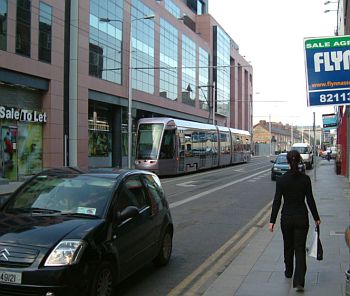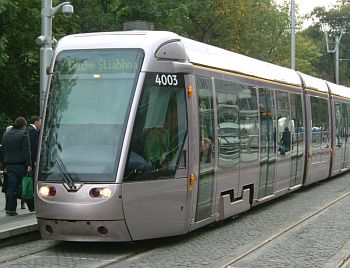 Dublin had an electric tram network for a period of about 50 years, from the end
of the 19th century to the mid-20th.
Dublin had an electric tram network for a period of about 50 years, from the end
of the 19th century to the mid-20th.
Throughout the 80s, it was clear that Dublin's transport problems required a
proper rail network. A suburban line was electrified and renamed the "Dublin
Area Rapid Transit" or DART. However, pressure grew for the reintroduction of
trams. Rather than a proper network, the government decided to build just two
separate lines. The new system was called "luas", an Irish word meaning "swift"
and consists of a Green line, running from the city centre to Sandyford, and a
Red line, running from the city centre to the vastly expanded suburb of
Tallaght. Although these are operated by tram type vehicles, the tracks are on
the whole well separated from motor traffic. In the case of the Green (=
Sandyford) line, nearly all the track follows an earlier suburban rail line.
The Red line has been largely built in side-streets which never carried heavy
traffic. In effect, both lines are suburban railways bringing passenger from
outlying districts into the centre. The vehicles themselves and the operating
company are French.
26 Citadis 301A vehicles were built by Alstom for the Red Line. Length: 30
metres. Capacity: 235 people (60 seats).
14 additional Citadis 301A vehicles with extra centre sections have been built
by Alstom for the Green Line. Length: 40 metres. Capacity: 300 people (80
seats).
The trams are standard European gauge, 1435 mm. (4' 8.5") unlike the existing
rail lines in Ireland which adhere to the Irish gauge width (5' 3").
|


|










